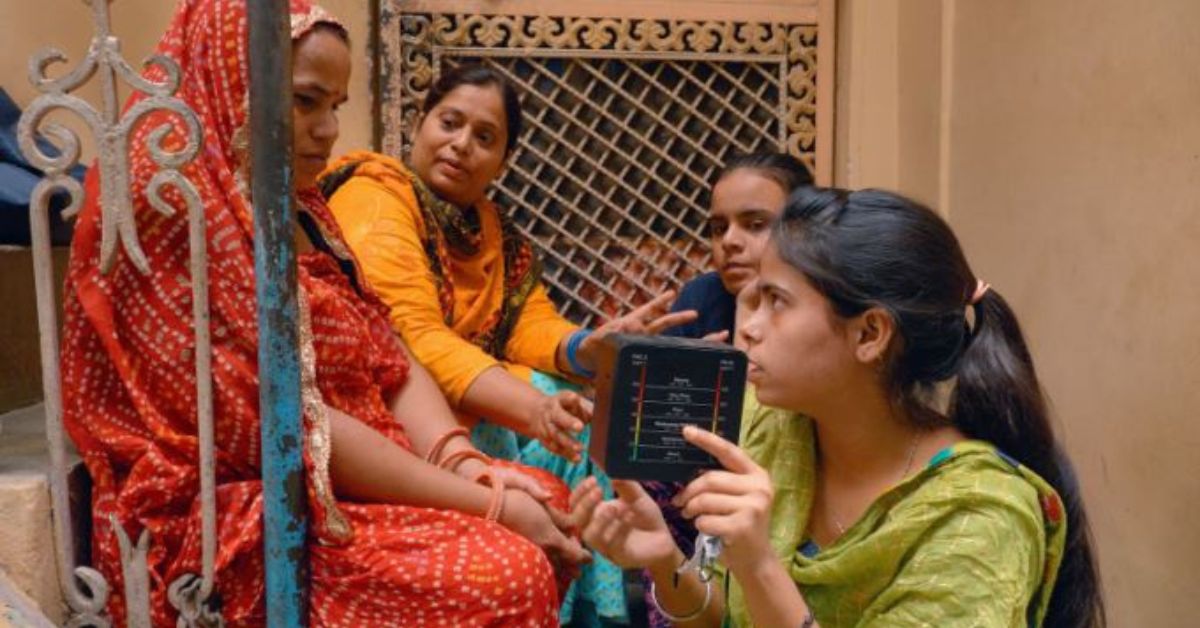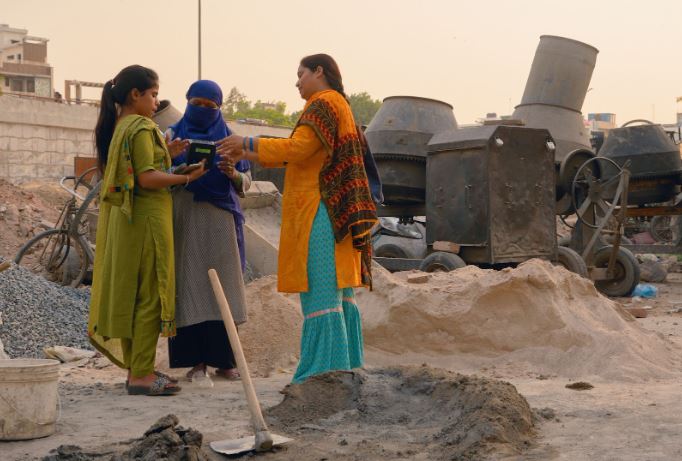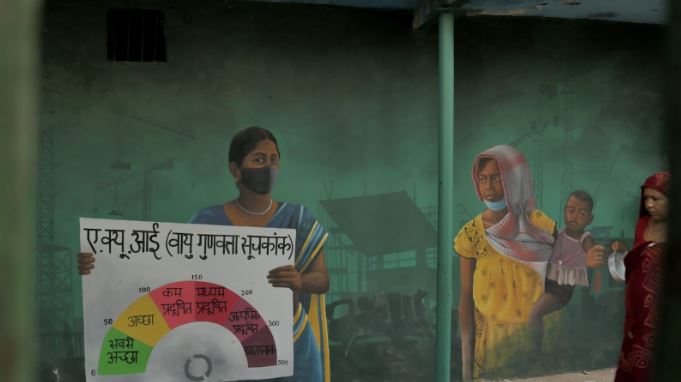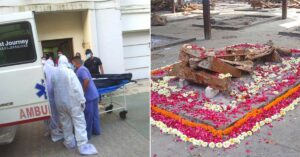‘It’s Severely Hard to Breathe’: Delhi’s Women Construction Workers Fight Pollution
A survey shows that 94 per cent of women construction workers never raise their voices against air pollution at their workplace for fear of losing their jobs. But they continue to be the party most affected by rising dust levels in the capital.

This article has been sponsored by Wingify Earth.
Delhi is a city perenially under construction. From overbridges to connecting roads and metro lines to colonies, it is always growing. Over the last few decades, construction dust has become one of the biggest contributors to the city’s pollution. As per a survey, rising dust at the capital’s under-construction sites contributes to nearly 30% of the toxic air in its surroundings.
Despite various government efforts, construction sites continue to violate procedural norms, including covering large heaps of sand or installing metal sheets around the area. Even as the city continues to be harpooned by floating dust particles, it is the construction workers, the agent zeros, that are most affected by it.
A survey released this year shows that a whopping 94% of women construction workers never raise their voices against pollution at their workplace for fear of losing their jobs. These women live in shanties at Delhi’s margins, which are the most polluted areas in the capital. Thus, for them, air pollution is a double whammy.
“Our eyes itch constantly and we face severe difficulty in breathing. Coughing, seasonal ailments, and allergies are common, and our skin also gets affected,” says Shakuntala, a construction worker who lives in the Bakkarwala colony, adding that while she somehow manages to finish off her work at construction sites, she feels the real effect of pollution when she comes home and tries to cook food for her family.
Shakuntala, and many others like her, are now connected with the Mahila Housing Trust – a national NGO that works to empower women labourers. In a special project with another non-profit, Help Delhi Breathe, MHT is helping women construction workers deal with the on-ground impact of air pollution at their workplace.

(Image Courtesy: Help Delhi Breathe/Sundeep Bali)
Towards a sustainable future
Between August 2021 to April 2022, the two organisations collaborated with women construction workers in Delhi’s Bakkwarwala, Gokulpuri and Sawda Ghevra areas as part of an extensive awareness campaign on air pollution.
While the women admitted to facing the wrath of air pollution at construction sites, they were afraid to act on it. Of the 400 women surveyed, 75% admitted to feeling sick and uncomfortable when the air quality was poor, and 73% reported having either asthma, coughing, skin allergies, or breathing difficulties.
As part of the awareness campaign, hundreds of women were targeted with suggestions to make changes at their workplaces and homes. A key aspect of this drive was Air Quality Index (AQI) ambassadors – women construction workers who were trained to understand AQI in their surroundings and inform people about the impact of air pollution.
Over eight months, the organisations trained about 75 women to become AQI ambassadors and read special AQI monitors. They also conducted a mobile storytelling workshop and informed women about the Green Delhi app, which they can use to complain about illegal construction activities or violations at their workplace. These ambassadors now tour the streets of Delhi to teach women construction workers about AQI mapping. “Women and children are among the first to bear the brunt rising from poor air quality, leading to immediate implications on health and livelihoods. Our women AQI ambassadors in Delhi are leading the change towards better air quality and building a more sustainable future,” MHT said in a statement.

“We organise rallies, distribute pamphlets, go to each woman in the colony to make them understand that air pollution is a real thing,” says Zarina, an AQI ambassador and a resident of Sawda. Her team helps women construction workers understand AQI, what its different levels mean, and what they can do to combat it.
Saroj, another AQI ambassador says, “The AQI monitors have helped us understand something we had only heard about over the years. I used to hear about air pollution on the news but never understood how it is recorded. The device helps me read it and analyse pollutants in my surroundings.”
Measuring AQI
The women have also been taught to measure AQI at their construction sites and what steps they can do to deal with it. “We make sure to wear masks, full-sleeved clothes, and get water sprinkled at the construction site,” Shakuntala says. MHT and Help Delhi Breathe have mobilized and enabled Delhi’s construction workers to understand the impact of air pollution, apart from building support among local administration in the capital and protecting women who are most exposed to air pollution.
Sprinkling water at construction sites is one of the key steps in preventing dust pollution. As per the Central Pollution Control Board (CPCB) guidelines, apart from this, construction sites are supposed to cover dust using plastic or tarpaulin sheets. Any easily airborne material must be contained and construction waste should be kept within the premise.

As mentioned, construction dust is one of the biggest pollution contributors. In November 2021, when the AQI crossed 360+, the Supreme Court placed a temporary ban on construction activities in the city as a measure to mitigate air pollution. However, despite the ban, roads were dug up in areas in South and Central Delhi. Construction work went on without proper dust control measures.
Surprisingly, Delhi witnessed a pollution-fuelled summer this year. Environment Ministry data shows that Delhi did not have a single ‘good air day’ in 2022, and the air quality was satisfactory or modest at best. Dust also contributed to pollution levels in Central Delhi due to the ongoing construction of Central Vista. As per a report, it was observed that a five-foot-high heap of soil was dumped outside the pavement of the Ministry of External Affairs. Even the road connecting South to Central Delhi in front of the India Gate has been filled with floating dust particles, affecting construction workers the most.
“We have been instructed to tell fellow male construction workers and even our bosses to sprinkle water in our surroundings as we work,” Shakuntala adds. The women also actively use the Green App to report environmental violations at construction sites.
At such a time, the impact of MHT and Help Delhi Breathe’s campaign has been manifold.
Over eight months, through the help of murals in these colonies or media reports, the campaign reached about 1 lakh construction workers, trained 75 women in reading AQI, taught 19 women to use Delhi’s Green App, and engaged with three MLAs, thus bringing to the fore solutions for women most affected by Delhi’s air pollution.
Wingify Earth encourages such creative solutions to empower citizens and parties that deal with pollution first-hand. Additionally, to further substantiate its efforts in cutting down air pollution for construction workers, especially women, Wingify Earth is willing to pool its resources to set up a similar chapter in other districts of Delhi.
Sources:
When the dust settles by Help Delhi Breathe; published on May 11, 2022.
Dust pollution unchecked in Delhi despite ban by Nikhil M Babu; published on November 16, 2021 courtesy The Hindu.
Air pollution from construction by Sumaira Abdulali; published on November 29, 2021 courtesy The Times of India.
Pollution norms bite the dust at Central Vista by Nikhil M Babu, published on March 3, 2022 courtesy The Hindu.
If you found our stories insightful, informative, or even just enjoyable, we invite you to consider making a voluntary payment to support the work we do at The Better India. Your contribution helps us continue producing quality content that educates, inspires, and drives positive change.
Choose one of the payment options below for your contribution-
By paying for the stories you value, you directly contribute to sustaining our efforts focused on making a difference in the world. Together, let's ensure that impactful stories continue to be told and shared, enriching lives and communities alike.
Thank you for your support. Here are some frequently asked questions you might find helpful to know why you are contributing?


This story made me
-
97
-
121
-
89
-
167
















